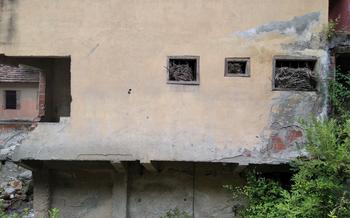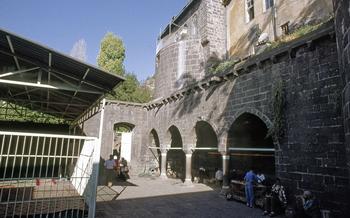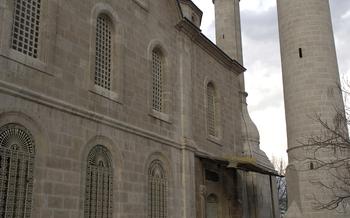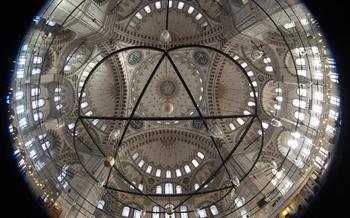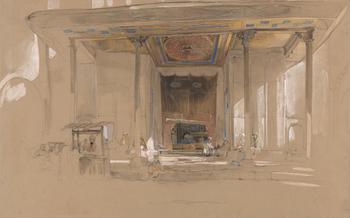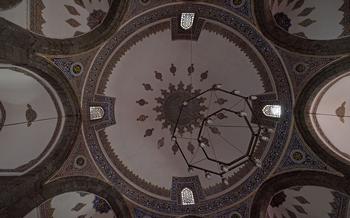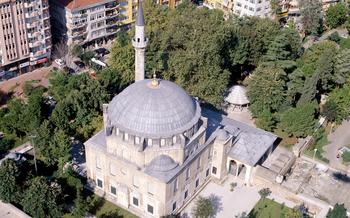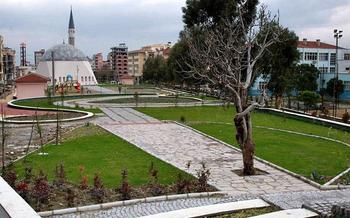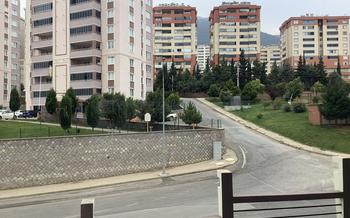
Hatay Ulu Camii (The Great Mosque)
- The Great Mosque: A Timeless Masterpiece
- Historical Significance: A Journey Through Time
- Architectural Marvel: A Fusion of Styles
- Spiritual Sanctuary: A Place of Worship and Reflection
- Cultural Hub: A Place for Gathering and Learning
- Visitor Etiquette: Honoring Traditions
- Exploring the Neighborhood: Hidden Gems
- Timing Your Visit: Capturing the Essence
- Unveiling the Minaret: A Symbol of Faith
- The Courtyard: A Tranquil Oasis
- The Mihrab: A Sacred Focal Point
- The Minbar: A Platform for Guidance
- The Qiblah: A Direction of Unity
- The Madrasah: A Seat of Learning
- Insider Tip: Unveiling Hidden Treasures
The Great Mosque: A Timeless Masterpiece
The Hatay Ulu Camii, also known as the Great Mosque of Hatay, stands as a testament to the region's rich history, architectural prowess, and cultural significance. Its origins can be traced back to the 13th century, during the reign of the Mamluk Sultanate. Over the centuries, it has undergone several renovations and expansions, each contributing to its unique blend of architectural styles and symbolic importance.
The mosque holds immense religious significance for the Muslim community in Hatay. It serves as a central place of worship, where locals and visitors gather for daily prayers, sermons, and religious gatherings. The intricate carvings, mosaics, and calligraphy adorning the mosque's interior create a captivating atmosphere that inspires devotion and contemplation.
Beyond its religious significance, the Hatay Ulu Camii is a symbol of Hatay's rich heritage and cultural diversity. It represents the fusion of Islamic and Byzantine architectural influences, showcasing the region's crossroads of civilizations. This architectural masterpiece stands as a reminder of the city's historical significance and its enduring legacy as a center of trade, culture, and religious harmony.
Historical Significance: A Journey Through Time
The Hatay Ulu Camii, also known as the Great Mosque of Antakya, stands as a testament to Hatay's rich Islamic heritage, dating back to the early days of Islam in the region. Originally built in the 7th century under the Arab Umayyad dynasty, the mosque has undergone several renovations and expansions throughout history, reflecting the changing political and cultural landscapes of Hatay.
In the 13th century, the mosque was significantly expanded and embellished under the rule of the Mamluk dynasty. This period saw the addition of the stunning minaret, which has become an iconic landmark of the city. The mosque also served as a madrasah (Islamic school) during this time, contributing to the intellectual and religious development of Hatay.
In the 16th century, the mosque underwent further renovations under the Ottoman Empire, which ruled Hatay for over four centuries. The Ottomans added the impressive courtyard, complete with an ablution fountain, and made several modifications to the interior of the mosque, reflecting their own architectural style and artistic traditions.
Throughout its long history, the Hatay Ulu Camii has played a pivotal role in the development of Hatay's Islamic identity. It has been a place of worship, learning, and community gathering, serving as a spiritual and cultural center for the region's Muslim population.
Architectural Marvel: A Fusion of Styles
The Hatay Ulu Camii represents a harmonious blend of Islamic and Byzantine architectural elements, showcasing the region's rich cultural influences. The mosque's exterior captivates with its intricate carvings and stunning mosaics, while the interior exudes a serene atmosphere with elegant arches and columns. Its stunning courtyard, adorned with a serene fountain, offers a tranquil oasis for contemplation.
The mosque's design showcases a fusion of architectural styles, with Islamic influences seen in the pointed arches, domes, and intricate calligraphy. Byzantine elements are evident in the use of mosaics and the overall symmetry of the structure. The intricate carvings on the minaret, depicting geometric patterns and floral motifs, are a testament to the craftsmanship of the artisans who built this magnificent structure.
The mosque's prayer hall, with its rows of columns and arches, creates a sense of spaciousness and grandeur. The ceiling is adorned with intricate patterns and calligraphy, drawing the eye upwards and adding to the awe-inspiring beauty of the space. The overall effect is one of harmony and balance, blending the best of both Islamic and Byzantine architectural traditions.
Spiritual Sanctuary: A Place of Worship and Reflection
The Hatay Ulu Camii serves as a spiritual sanctuary for Muslims in the region, offering a tranquil space for worship, reflection, and connection with the divine. The mosque's serene atmosphere invites worshippers to immerse themselves in religious devotion, fostering a sense of peace and tranquility.
The mihrab, a sacred niche in the wall indicating the direction of Mecca, stands as a focal point within the mosque. Its intricate designs, calligraphy, and ornamentation create a mesmerizing visual spectacle, drawing the eyes and hearts of worshippers.
The minbar, a raised platform used by the imam to deliver sermons and speeches, holds a significant position within the mosque. Crafted with exquisite craftsmanship and adorned with intricate carvings, the minbar serves as a symbol of religious guidance and authority.
During daily prayers, the mosque comes alive with the melodious voices of worshippers reciting verses from the Quran. The imam leads the congregation in prayer, guiding them through the spiritual journey. The mosque's acoustics amplify the recitations, creating a harmonious and uplifting atmosphere.
The Hatay Ulu Camii is not just a place of worship but also a place where Muslims gather for religious gatherings, celebrations, and events. These gatherings foster a sense of community and belonging, strengthening the bonds between worshippers and promoting unity and understanding.
Whether you are a devout Muslim seeking spiritual fulfillment or a curious traveler eager to explore the region's religious heritage, the Hatay Ulu Camii offers a profound and enriching experience.
Cultural Hub: A Place for Gathering and Learning
The Hatay Ulu Camii serves as a vibrant cultural hub, fostering a sense of community and providing opportunities for learning and exchange. The mosque's courtyard transforms into a lively gathering space, where locals and visitors alike come together to socialize, share stories, and celebrate religious festivals. The mosque also houses a madrasah (Islamic school), which has played a crucial role in educating generations of students in Islamic studies and sciences. This educational institution has contributed significantly to the preservation and transmission of Islamic knowledge and traditions in the region.
Beyond its religious and educational functions, the Hatay Ulu Camii also serves as a platform for cultural exchange and understanding. Visitors from different backgrounds and cultures are welcome to explore the mosque's premises, learn about its history and significance, and engage in meaningful conversations with the local community. This cultural exchange fosters mutual respect, understanding, and appreciation among people of diverse backgrounds, contributing to the richness and diversity of Hatay's cultural landscape.
Visitor Etiquette: Honoring Traditions
Visitors to the Hatay Ulu Camii are expected to demonstrate respect for the religious and cultural significance of the site. Appropriate attire is essential, with modest clothing that covers the shoulders and knees for both men and women. Visitors should avoid wearing shorts, tank tops, or revealing clothing.
Upon entering the mosque, it's customary to remove your shoes and place them neatly on the designated shelves. A serene and respectful demeanor is expected within the mosque, and visitors should avoid loud conversations or disruptive behavior.
Photography is generally permitted within the mosque, but it's important to ask permission from the mosque's caretaker or a local official before taking any photographs. Using a flash or tripod is generally discouraged to minimize disturbances during prayer times.
Observing local customs and courtesies is essential to create a harmonious and respectful environment. Visitors should avoid pointing their feet towards individuals or religious objects and refrain from touching or leaning against sacred spaces.
By following these guidelines, visitors can contribute to preserving the sanctity of the Hatay Ulu Camii while enriching their understanding of Turkish culture and Islamic traditions.
Exploring the Neighborhood: Hidden Gems
Beyond the walls of the Hatay Ulu Camii, the surrounding neighborhood offers a treasure trove of hidden gems waiting to be discovered. Just a short stroll away, you'll find the vibrant Hatay Bazaar, a bustling marketplace where you can immerse yourself in the sights, sounds, and aromas of traditional Turkish commerce. Here, you can haggle for unique souvenirs, sample mouthwatering local delicacies, and uncover the charm of authentic Turkish handicrafts.
For a culinary adventure, venture into the narrow alleys and uncover hidden eateries serving up authentic Hatay cuisine. Tantalize your taste buds with specialties like künefe, a sweet cheese pastry drenched in syrup, or savor the flavors of freshly grilled kebabs, a staple of Turkish gastronomy. Don't miss the opportunity to indulge in the region's famous olive oil, renowned for its rich flavor and health benefits.
As you wander through the neighborhood, don't forget to look up and admire the charming architecture that adorns the streets. Historic buildings, many with intricate facades and colorful tiles, line the paths, offering a glimpse into Hatay's rich past. Take your time to explore the nooks and crannies, where you might stumble upon hidden courtyards, tranquil gardens, or even a glimpse of the city's ancient fortifications.
Unveiling the charm and authenticity of Hatay's old town is a journey that will leave you enchanted. Whether you're browsing the bustling bazaar, savoring local delicacies, or simply soaking in the atmosphere, the neighborhood surrounding the Hatay Ulu Camii promises a unique and unforgettable experience.
Timing Your Visit: Capturing the Essence
The Hatay Ulu Camii offers a unique and enriching experience at any time of day. However, to fully immerse yourself in its tranquility and spiritual ambiance, consider visiting during the early morning or late afternoon when the crowds are fewer. This will allow you to appreciate the mosque's serene atmosphere and intricate details without distractions.
For an even more immersive experience, plan your visit to coincide with special events or festivals held at the mosque. These events provide a glimpse into the vibrant religious and cultural traditions of Hatay. Check local calendars or inquire with the mosque's administration for information on upcoming events.
To avoid the rush and ensure a meaningful exploration, steer clear of peak tourist hours, particularly during the summer months. By planning your visit during the shoulder seasons (spring or autumn), you can enjoy a more intimate and authentic experience of this remarkable mosque.
Unveiling the Minaret: A Symbol of Faith
Rising majestically into the sky, the minaret of the Hatay Ulu Camii stands as a testament to the mosque's architectural prowess and its significance as a symbol of faith. Constructed in the 13th century, the minaret's cylindrical form and intricate brickwork showcase the craftsmanship of its builders. Its unique design features include intricate geometric patterns and decorative bands that add depth and visual interest to its towering presence.
From the minaret's balcony, the muezzin's call to prayer reverberates through the air, echoing across the city and inviting the faithful to join in worship. The muezzin's melodious voice, amplified by the minaret's acoustics, creates a spiritual ambiance that permeates the surrounding neighborhood, reminding all who hear it of the power of faith and the beauty of Islamic traditions.
Over the centuries, the minaret has witnessed countless changes in Hatay's skyline, from the rise and fall of empires to the transformation of the city itself. It has stood steadfast, a silent observer of history, its presence a constant reminder of the enduring legacy of the Hatay Ulu Camii and the faith that it represents.
The Courtyard: A Tranquil Oasis
The courtyard of the Hatay Ulu Camii, embraced by the mosque's majestic structures, exudes an air of serenity that invites contemplation and spiritual reflection. As you step into this peaceful haven, the first thing that catches your eye is the ablution fountain, a symbolic element in Islamic rituals. Believers perform ablution, a ritual cleansing, before prayers, and the fountain's gentle flow of water adds a soothing ambiance to the courtyard.
The courtyard is not just a functional space but also a visual delight. Decorative elements, such as intricate tilework and colorful mosaics, adorn the walls, adding a touch of artistry to the serene surroundings. Trees and meticulously landscaped gardens provide a verdant contrast to the stone architecture, creating a tranquil oasis amidst the bustling city.
Whether you seek a moment of solitude or wish to immerse yourself in the mosque's spiritual atmosphere, the courtyard offers a perfect setting. Take a seat on one of the benches, let the gentle breeze caress your face, and allow the tranquility of the courtyard to wash away the stresses of daily life.
The Mihrab: A Sacred Focal Point
The mihrab, an essential feature of Islamic architecture, holds a prominent position in the Hatay Ulu Camii. This sacred niche, indicating the direction of qiblah (the direction of prayer towards Mecca), serves as a focal point for worshippers during their prayers. Intricately designed and adorned with calligraphy and ornamentation, the mihrab is a testament to the mosque's artistic and spiritual significance.
The imam, the leader of prayers, stands in the mihrab during each prayer, leading the congregation in their devotions. Its elevated position symbolizes the imam's role as a guide and spiritual leader, connecting the community with the divine. The mihrab's exquisite craftsmanship and intricate details reflect the deep reverence and devotion held by the Muslim community towards their faith.
For visitors, the mihrab offers a glimpse into the spiritual heart of the mosque. Its beauty and majesty inspire a sense of awe and contemplation, inviting reflection on the profound significance of faith and devotion in the lives of believers. The mihrab stands as a reminder of the enduring power of Islamic traditions and the deep connection between architecture and spirituality.
The Minbar: A Platform for Guidance
The minbar, an elevated platform within the Hatay Ulu Camii, holds a significant place in Islamic architecture, serving as a stage for delivering sermons, speeches, and religious guidance to the congregation. Crafted with intricate designs, fine materials, and skilled craftsmanship, the minbar showcases the mosque's artistic heritage.
The imam, the spiritual leader of the mosque, ascends and descends the minbar during religious services, using it as a platform to deliver sermons, lead prayers, and provide religious teachings to the faithful. Its elevated position allows the imam's voice to carry throughout the mosque, ensuring that his words reach every corner of the vast prayer hall.
Beyond its practical function, the minbar also carries historical and cultural significance. It represents the authority and wisdom of the imam, symbolizing his role as a guide and teacher within the Muslim community. Over the centuries, countless imams have stood upon the minbar of the Hatay Ulu Camii, leaving their mark on the mosque's rich history and shaping the spiritual lives of generations of worshippers.
The Qiblah: A Direction of Unity
In the Hatay Ulu Camii, the qiblah holds a profound significance, guiding the faithful towards Mecca during their prayers. This sacred direction represents the unity and cohesion of the Muslim community, regardless of their location. The mihrab, a niche in the wall indicating the qiblah, is adorned with intricate designs and calligraphy, emphasizing its importance.
Standing within the mosque, one can feel a sense of connection to fellow Muslims worldwide, all facing the same direction in reverence and devotion. The qiblah serves as a reminder of the shared beliefs and practices that unite the Islamic community, transcending geographical and cultural boundaries.
Anecdotes abound of travelers who have experienced a profound sense of spiritual connection while praying towards the qiblah in the Hatay Ulu Camii. For many, it is a moment of deep reflection and connection with their faith.
Whether you are a devout Muslim or simply a curious visitor, understanding the significance of the qiblah can enhance your appreciation of the Hatay Ulu Camii and the rich Islamic heritage it represents.
The Madrasah: A Seat of Learning
The Hatay Ulu Camii complex also includes a madrasah, or Islamic school, which played a crucial role in educating students in religious studies and various sciences. Established in the 16th century, the madrasah provided a comprehensive education to young scholars, fostering knowledge and understanding of Islamic teachings.
The architectural features of the madrasah reflect its educational purpose, with spacious classrooms, a library, and living quarters for students and teachers. Intricate carvings, colorful tiles, and calligraphy adorn the walls, creating an inspiring environment for learning.
Students at the madrasah studied a wide range of subjects, including Quranic studies, Islamic jurisprudence, Arabic language and literature, mathematics, astronomy, and philosophy. The curriculum was designed to produce well-rounded individuals who could contribute to the intellectual and spiritual development of the community.
Throughout its history, the madrasah has produced many notable scholars, theologians, and leaders who have made significant contributions to Islamic scholarship and society. It served as a center of learning and enlightenment, shaping the intellectual landscape of Hatay and the wider region.
Even today, the madrasah continues to function as a place of learning, offering classes in Islamic studies and Arabic language to students of all ages. Visitors to the Hatay Ulu Camii can explore the madrasah's historic classrooms and library, gaining a glimpse into the rich educational heritage of this sacred site.
Insider Tip: Unveiling Hidden Treasures
Beyond the main attractions of the Hatay Ulu Camii, there are hidden treasures waiting to be discovered for the curious traveler. Seek out the secluded courtyard garden, a tranquil oasis adorned with vibrant flowers and trickling fountains, offering a serene escape from the bustling city. Uncover the intricate carvings and inscriptions etched into the walls, each telling a unique story of the mosque's past. Engage with the friendly locals who frequent the mosque, eager to share their personal anecdotes and insights, providing a glimpse into the mosque's living history. Embrace the opportunity to learn about traditional Islamic practices and customs, fostering a deeper understanding of the region's rich cultural heritage.
